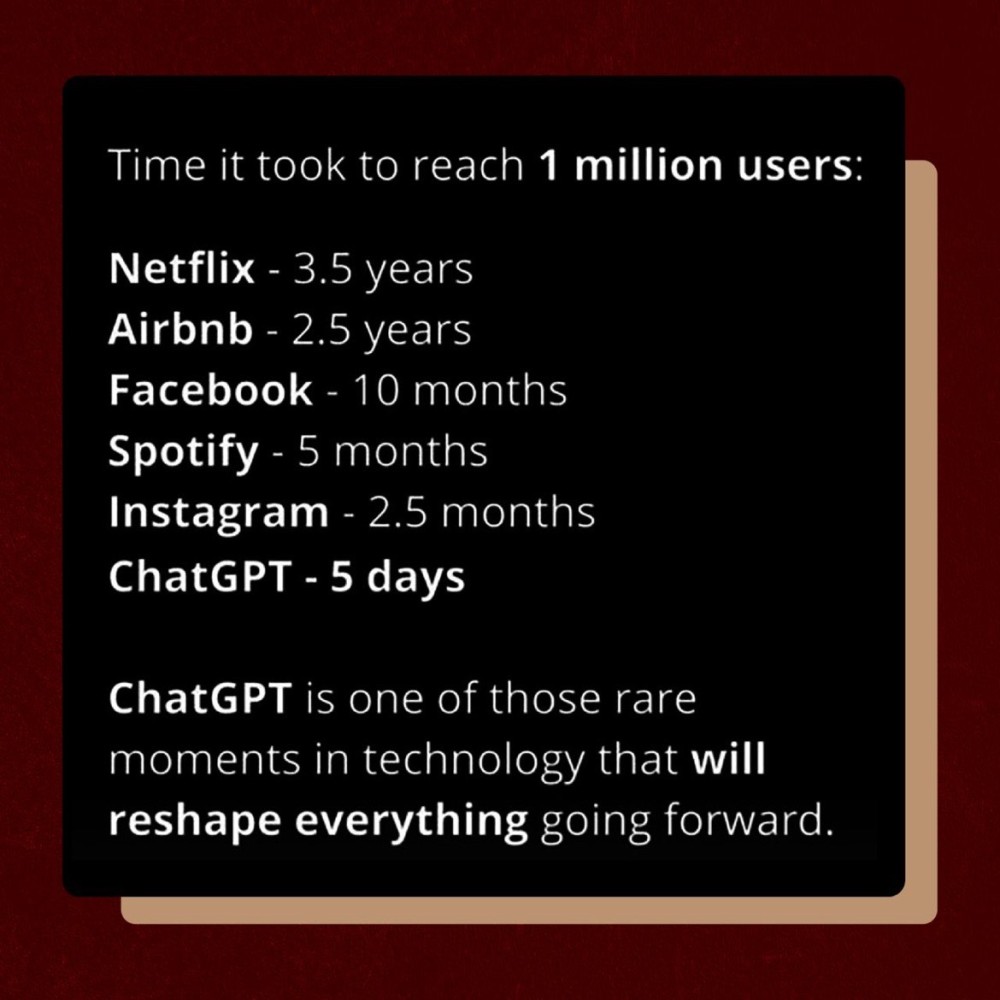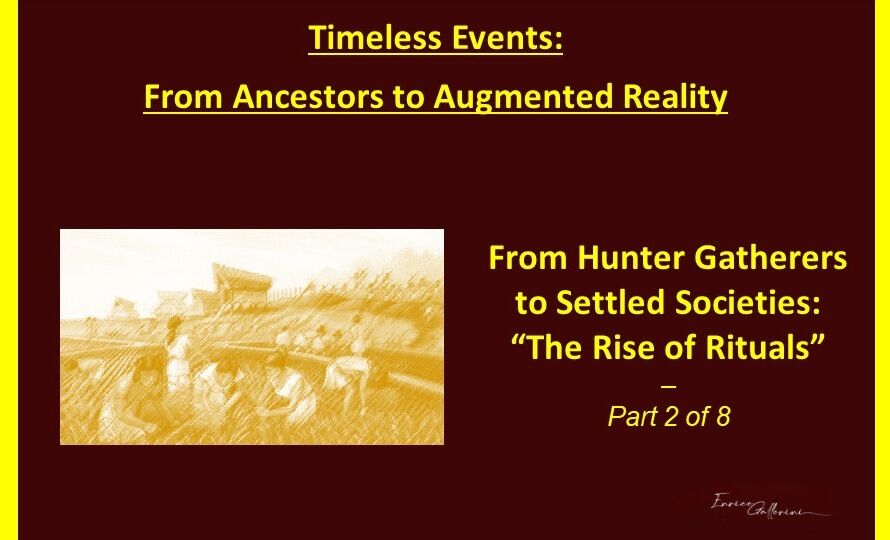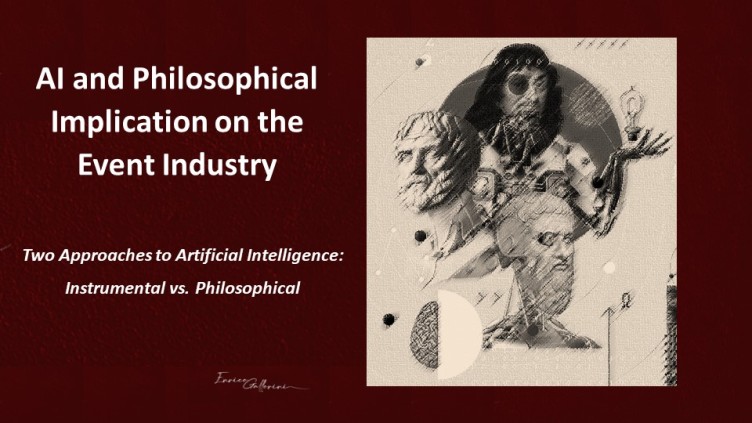ChatGPT’s ability to simulate language is not just a technical advance in “NLP” natural language processing but a passage of civilization that will undermine many economies, businesses, and markets.
For this reason, the exhibition industry must also investigate how and why this innovative technology will enter our sector, in the industries where our collective events represent the shared moment of confrontation and evolution for our target niches, and what the effects will be in them.
Everyone is talking about ChatGPT, and many are keen to try the chatbot. It is free, for the moment, and therefore is often blocked due to excess requests.
At the time of writing, it has reached 200m users, an incredible number compared to any other innovative tech when they enter the market, and the speed of growth is just unprecedented.

But, as always happens with the introduction of new technologies, we must go beyond the curiosity and “hype” of the instant and better understand the deepest meaning of this radical change in language management.
I will try to give an interpretation of the phenomenon with a perspective connected to our sector and how this new technology can change many dynamics.
ChatGPT and the issue of synthetic languages
Facing the question of synthetic and simulated languages like ChatGPT today means facing an epochal and not an episodic passage of civilization (Cosimo Accoto 2022); therefore, my reasoning starts from the assumption that we are at the beginning of a change. We can imagine trajectories, but we should observe and study how they evolve in the coming months and years, specifically focusing on the exhibition industry.
The use of ChatGPT is much commented on at the moment but perhaps little explored and understood (technologically and socially). What it can mean for exhibitions and large events has been studied even less, and certainly not in depth.
From a technical point of view, we are talking about a highly refined algorithm that manages a ‘large-scale linguistic model. (LLM or large language model). It is a generative socio-technical assemblage comprising different skills related to multiple computational architectures and information resources.
It can: simulate language in its textual form, adjust contextual mode, and archive knowledge and information to execute linguistic instructions and tasks. It synthesizes topics with scalar refinement, originates sequences of arguments and step-by-step reasoning attempts, articulates answers, and builds dialogue. These things result from a complex orchestration comprising software programs, data, and information archives. Deep learning algorithms, human reinforcement, and mathematical-stochastic models of the language drive the technology.
Therefore, it is a set of intertwined engineering-computational techniques and operations (training on code, transformers, pre-training modeling, instruction tuning, words tokenization, and reinforcement learning with human feedback) capable of statistically sequencing the natural human language.
But we must remember that: All this is without a meaningful relationship with reality.
That is to say, it doesn’t know anything about the world and has no understanding of meaning.
What is ChatGPT?
As always, in a strategic path, we must start with the information we have from the ‘beginning”‘ For this, I use the ‘Cosimo Accoto way’ of presenting the ChatGPT meaning.
What is an LLM (large language model)?
It is a mathematical model of the probability distribution of words in a written language that strives to minimize cross entropy (i.e., the gap between two potential frequency distributions), thereby maximizing its performative capacity as a text predictor.
This approach results from a long journey (Li, 2022) in the modern history of natural language processing (NLP). Starting from the Markov chains and Turing Models at the beginning of the 20th century applied to literature (sequence of vowels and consonants in a novel) and passing the works of Shannon and Weaver in the mid-fifties on the measurement of entropy and the distribution of probabilities (n-grams and probabilistic sequence of words in the language) arrives at the beginning of the 2000s with (Bengio, 2002) and colleagues to the application of artificial neural networks for natural language processing (neural NPL). Recent developments include transformers capable of incorporating the contextual dimension of words in sentences into the probabilistic language analysis.
For this, as written by Shanahan (2022): “It is very important to keep in mind that this is what large language models actually do.”
Suppose we give an LLM the request “the first person to walk on the moon was…” and suppose the reply is “Neil Armstrong.”
What are we actually asking for?
To a significant extent, we are not asking who was the first to walk on the moon.
We are asking the model the following question: given the statistical distribution of words in the vast ‘corpus publico‘ of texts (for now in English), which words are most likely to follow the sequence “The first person to walk on the Moon was…”?
Statistically, according to the system and its articulated algorithm, a statistically excellent answer to this question is “Neil Armstrong.”
The need to imagine new dimensions of exhibitions
We have re-discovered the importance of ‘live’ events and how much the centrality of the ‘human’ experience is at the basis of the very existence of collective events, which we generally call ‘exhibitions.’
This ‘human effect’ is not only the keystone on which events are based, but it is also the reason why today there is a rediscovery of the human element throughout the customer journey: the greeting of a human when you arrive at the venue, the welcoming side of the onsite registration, the handshake in the exhibition floor, the smiles, looking into each other’s eyes, the dialogue made of physical interactions…
The example of ChatGPT, or rather the use of artificial intelligence that simulates human language, could, on the one hand, seem like a new and important challenge to the world of the media. (Of which exhibitions are a part.) It knows how to base itself on content. But on the other hand, it is a huge opportunity to refresh the complexity of the true ‘intelligentsia,’ which is the basis of the production of a collective event…
I would like to go deeper into this point.
ChatGPT does what it’s supposed to do in its actual standard use. And it does it very well. It has an extraordinary ability to synthesize putting the main things together. But if you ask for a minimum of reasoning on less usual things, it doesn’t work.
For example, a ‘simple’ question, such as “Laura’s mother has two children: is one of them called Laura?”. And it answers that there are not enough elements in the question to answer correctly.
This highlights that there is no understanding of the text.
Today this technology is just like the spelling book or calculator that doesn’t understand numbers, however precise the calculations.
That is, it behaves intelligently, even though it is not intelligent. Tools like ChatGPT emphasize the separation between:
- acting successfully, as artificial intelligence does
- acting intelligently to achieve success, as a person generally does.
ChatGPT has an enormous ability to act but without ‘intelligence.’
This is closely connected to the experience of virtual events, hybrid platforms, and all the more or less refined ‘matchmaking’ tools.
They are tools.
They are essential to make the experience of the collective event more complete and enhance it, but to work, you need commitment, creativity, a deep understanding of the needs of the beneficiaries (visitors and exhibitors), precise structuring of requests, and profound use of human intelligence. Then the tools do their job very well.
I have believed (for years now) that maybe we should stop talking about ‘intelligence’ when referring to all these tools, starting from ChatGPT.
To do something successfully, a human needs intelligence, even a minimum. Today several processes can be done by machines with zero intelligence. They can do it even better than us. But they do it computationally, not intelligently.
Today its answers are trivial. Perhaps they will be less so tomorrow, but we and our industry must focus on ‘distinguishing’ through the Human Touch of the experience at the exhibition.
In particular, we need to focus on the best way to make the Exhibition Experience the most “Individual and Social” possible, starting from registration welcoming, the support for the visit, and enhancing the intelligence that is there; it’s behind the tools.
Nothing is more pleasant at an event than receiving a warm ‘welcome’ with a beautiful ‘human’ smile. We started from there and must stay there for the good of that incredible ‘human experience’ in all our industry business models.
Having machines that welcome and smile just doesn’t work; from a neurological point of view, it pushes you away and creates anxiety and stress!
From this simple ‘physical’ element, as important as it is irreplaceable, returning to the value of the ChatBot, we understand more and more often that there really is a need to include more ‘philosophers’ (thinkers) and fewer ‘technicians/analysts’ within our organizations, because the tools are improving. Although there is always technical work, it will be less value-added. What changes completely is understanding what to do with these tools – starting from the ‘why.’
We must ask ourselves how far this structured evolutionary form of tools can go, and we must imagine that there is no theoretical limit to their improvement to date.
But there is a limit on resources – financial, computational, investments, and industrial interest. When I think of beneficial and fundamental technologies that have disappeared, I think of the airplane Concorde. This technology exists but is not convenient, so it is not used.
Returning to our industry, there are things that AI can easily replace. Some programs know how to write articles. Simple items, maybe. And tomorrow, for a content provider, there will be no reason for a journalist to do the ‘simple’ part. But no program can replace the depth of analysis of an article, for example, from an expert, its ability to go beyond the mere publication of words into what they imply and entail for the reference industry. Even if I’m starting to suspect that it may not work today, artificial intelligence will be able to do that tomorrow, too. How will it be able to do all the tasks, the jobs that a person carries out today? But the important thing is to understand that intuition, the connection of the various pieces of the puzzle, and strategic vision are very complex activities that require:
- Experience
- Intuition
- Passion
At the output level of a process, we must imagine that in the short term, we may be unable to distinguish the output produced by a machine and a human. But the input and, above all, the process will remain different.
Some things are made by men and are valued because men made them. The ‘artistic’ component of choice becomes unique for those who know how to imagine the future undermining the status quo.
The human being will have to focus more and more on the ‘Unicum’ of his thought, why things are done, and the process involved in that.
For this reason, it is also necessary to think within our exhibition system to develop ‘new’ professional figures and skills who know how to maximize the tools—introducing new disciplinary practices such as prompt engineering and design. Expert skills in making queries, instructions, data, and examples are usually the inputs used to solicit the machine to produce the desired output (a conversation, a text, a summary) through an optimized mathematical model on linguistic tokens.
Observing these simulation tools of reality, the Platonic text of the imitative arts comes to mind ‘The imitator knows nothing of the imitated thing that is worth anything’ wrote Plato in The Republic.
In its contemporary version, the terminology’ stochastic parrot’ was introduced.
From time to time, humans face the word taken by the machine either with clear condescension (there is no understanding of meaning) or with easy enthusiasm (a turning point in the generation of language). However, they are weak philosophical visions of the moment and the transition we are experiencing. They try to weaken or trivialize the disorienting cultural impact of the arrival of synthetic languages, which does not concern the question of assigning and recognizing or not intelligence, consciousness, or sentience to machines. Rather, and in perspective, the arrival of the ‘synthetic language’ (Bratton) deeply undermines and deconstructs (Gunkel) the apparatuses, domains, and institutional devices of discourse, the word, and the speaker, as well as of writing and authorship.
The speaking of the machine will be a more profound and disorienting operation in the long run.
This is perfectly connected to the Metaverse or the synthetic immersive worlds currently produced mainly for playful purposes, where after the initial hype, there is a strong ‘negationist’ vision. But they are present and are evolving quickly, and just look at the Gen-Alpha (children born from 2010 to 2024) that use these tools to understand that they are here to stay. As such, we are here to study them and put them at the service of humanity (for this reason, I’m creating a series of articles called “Building Block for the Exhibition of the future” that will cover all these innovations).
This pushes the role of the exhibition of the future even stronger. In contrast, a collective event where the industries meet and discuss hyper-specialized dynamics brings with it the real and intelligent ‘profiling’ of the value of participation.
It will not be the algorithm that participates in an exhibition, but the person, with his intelligence and his ability to create value.
More and more, the events will have to work on the value of this collective moment. Going in the direction that best preserves humanity, keeping that ‘sacred’ place (not only for its revenues) as human as possible, like an island of pure humanity, where the tools just reinforce the physical experience. Where humans gather and have that valuable experience live, humans meet and let’s keep the ‘machines’ away for now.
This step will also require a strong investment in all the people who support the exhibition throughout its duration. There could be no greater mistake (on my part) in predominantly making the exhibition experience up with tools/machines (turnstiles, screens, computer bots, etc.). At the same time, the strength of the collective event lies in speaking with real people. We should always be more oriented towards ‘solving problems and being informed rather than reporting a piece of data (in which case the machine would win but would destroy the human serendipity effect that makes our industry unique).
The central point is that we must prepare for what will happen in the next 10/15 years. The evolution of these technologies is accelerating. The impact it can have on exhibitions is partly limited if the event organizer can keep the HUMAN orientation of the experience towards the collective event clear and strong.
But the tool accelerates its acceleration.
And therefore, exhibitions must understand more and more what impact ChatGPT can have, for example, in their reference industry, because it is inevitable that there will be –as there was with the Internet and there will be with the Metaverse – technologies that arrived to stay.
True intelligence comes back into play; the role of the organizer is to understand and appreciate what will become of his reference niche in the near future.
In this regard, we will experience a ‘thump’ of disillusionment with these tools in a few months vis-a-vis what this new tool can really do. But in my opinion, ChatGPT must not be banned from our industry, nor must we pretend that it will not touch it, but it must be studied, taught, and enriched within our organization.
Companies should be given the tools to understand and use these new technologies.
I spoke about Blockchain as a foundational technology many years ago at the 2018 UFI conference. In other words, it generates new economies. Here we are talking about artificial intelligence, and we must have a different approach; we must start thinking about a non-utopian world of pre-retired people or really different skills. We are already heading towards a world where people work less; if they work more, it is because they work poorly.
They work less because they use their intelligence starting from the ‘why’ of things.
With Covid, I believe that we all understood that, at least in our context, the quality of human relationships and socialization is linked to the plurality of life and is no longer connected to how much one works.


